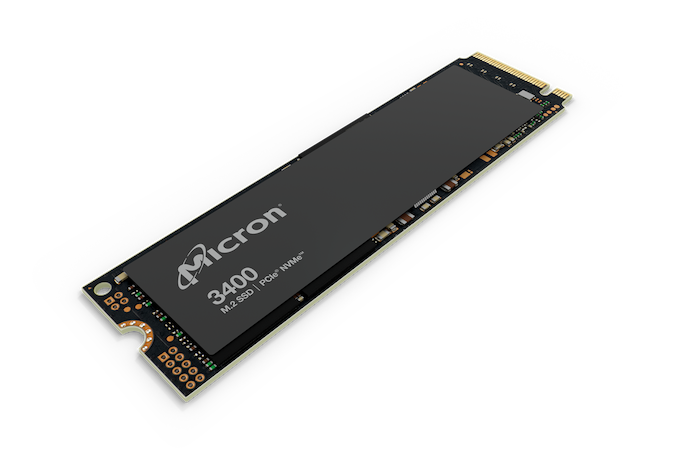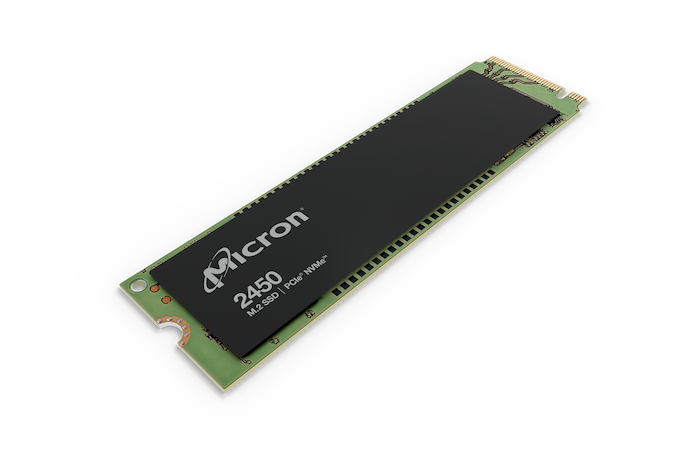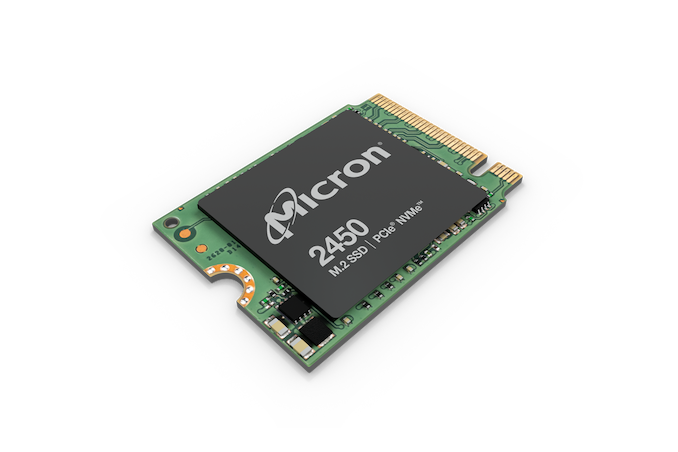Micron Announces PCIe 4.0 Client SSDs
by Billy Tallis on June 1, 2021 9:10 PM EST
In Micron's keynote today at (virtual) Computex, the memory manufacturer announced they have started shipping the companies first PCIe 4.0 SSDs, using their latest 176-layer 3D TLC NAND flash memory. The two new product families are the Micron 3400 and 2450 series client SSDs.
The 3400 series is their high-end client SSD, with double the read throughput of their preceding Micron 2300, and 85% higher write throughput. The 3400 uses Micron's latest in-house SSD controller design, and Micron is touting performance and power efficiency that make the drive suitable for applications ranging from notebooks to workstations. As is typical for high-end client PCIe 4.0 SSDs, the capacity options start at 512GB and go up 2TB.
The Micron 2450 series is a more entry-level design but still featuring PCIe 4.0 support. This one uses a third-party DRAMless controller, likely the Phison E19T (also believed to be used in the recently-announced WD Black SN750 SE). The 2450 is available in three different M.2 card lengths from the usual 80mm down to the 30mm card size suitable for extremely compact systems. The Micron 2450 series covers the more mainstream capacity range of 256GB through 1TB.
The most highly-awaited products with Micron's 176L 3D TLC might be the upcoming refreshed Phison E18 drives that threaten to dominate the high-end market segment, but Micron's own 176L SSDs will help bring this latest generation of NAND to a wider range of products, including pre-built systems where OEMs seldom offer options quite as high-end as a Phison E18 drive. Micron's new client SSDs are already in volume production and shipping to customers.














30 Comments
View All Comments
oRAirwolf - Tuesday, June 1, 2021 - link
I am happy to see another m.2 2230 option. Using a small (2230 or 2242) USB enclosure with these drives is super handy for very fast highly portable storage.deil - Wednesday, June 2, 2021 - link
yeah, a lot of times you dont have a choice as they are meant in laptops. I like them as they are expansions in places where you would not fit anything else. (my one have 2x 2242 drives, which is nice)regsEx - Wednesday, June 2, 2021 - link
Hope camera manufacturers will implement M.2 2230 instead of CFExpress. It's like 20 times cheaper.sameerhiware - Monday, November 21, 2022 - link
Won't work. SSDs are not designed to support camera use-cases.Techtree101 - Wednesday, June 2, 2021 - link
Is it safe on the drive's longevity to use these in external enclosures? I was hoping to get a 2TB external for occasional transport needs, but I worry the heat of this type of SSD will degrade them in shorter order.solidsnake1298 - Thursday, June 3, 2021 - link
NAND chips actually benefit from being a bit warm. Controllers, not so much. But, under typical single-user client work loads, controllers never reach temperatures that would be of concern. If you are installing it in an enclosure with little or no airflow and other heat sources, there are aftermarket NVMe heat sinks that should help.mode_13h - Friday, June 4, 2021 - link
> NAND chips actually benefit from being a bit warm.In what sense?
mode_13h - Friday, June 4, 2021 - link
SSDs seem to have built-in temperature sensors and will throttle, if necessary. Most of the time, a typical user isn't hitting a SSD hard enough for it to get anywhere near throttling.The biggest benefit from good SSD cooling is performance, if you really *are* pushing it. Because that lets you push it further, before it starts throttling.
wr3zzz - Tuesday, June 1, 2021 - link
Do Micron products differ from Crucial? I thought Crucial NVMe SSD use in-house controllers.mode_13h - Tuesday, June 1, 2021 - link
I don't know about current products, but older products often (if not always) used the same controllers. The Micron Linux tools would usually work with Crucial drives, as well.